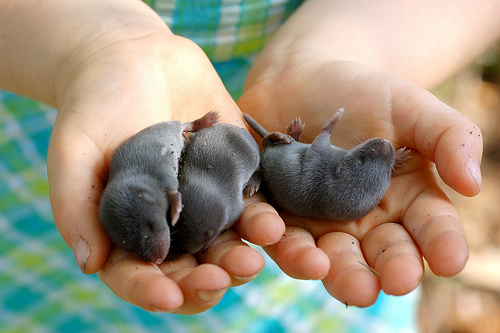If you live in Puget Sound and find a mole, you might be wondering what species it is. I have an easy way for you to tell them apart! In Puget Sound there are three moles species. They are:
- The Shrew-mole (Neurotrichus gibbsii) that is easily distinguished by its small size and lack of the usual mole spade-feet. They spend a lot of time above ground and prefer moist areas.
- The Coast mole aka Pacific mole (Scapanus orarius).
- The Townsend mole (Scapanus townsendii)
The last two moles are the ones that can give identification problems, as morphologically they look the same. They have the same gray to black pelage, short naked snout, and bare tail. However, the size difference is far greater between the Townsend mole and the Coast mole. Coast moles are only 6 to 7 inches in length or about the length of a dollar bill. The Townsend mole is about 8 to 9 inches long, which is about two inches longer than a dollar bill. This makes it the largest mole in North America.
In addition to size, Coast moles prefer drier and woodier habitats than Townsend moles. Townsend moles will go for more open habitat when they can such as pastures, meadows, and shrub forests. Coast moles have a far more extensive range along the west coast, and will utilize a greater variety of habitats such as sagebrush and dense woods.
When they occupy the same land, use a dollar bill as your guideline! If it is about the length of your dollar bill or shorter, from nose to tail tip, it’s a Coast mole. If it is about 2 inches longer, it is a Townsend mole.
Have you seen either of these moles? Let me know your experiences with them and where you tend to find them in the comments below!
Edit: I am working to start a separate blog from this one completely dedicated to moles! It won’t be a free wordpress site, so any donations would be greatly appreciated. I intend to write about moles from all over the world, and cover different topics from folklore to even the history of mole eradication. This will work towards my larger project of a book on moles.



I need help identifying between Townsend & Coastal Mole because it is the end of March. Some construction done on an access to a hillside house & this mole ended up in an empty box indoors. It’s about 9cm long. Could it be a young Townsend?
With younger moles it can be harder to identify due to them not being fully grown. However, about this time of year, most moles are dispersing from their nests and should be well over 9 cm. It’s not uncommon for the American Shrew Mole, that also lives in the Pacific Northwest to be about 10 cm, it is much smaller than the other two moles. They have a much longer, bare snout than the Townsend or Coast moles.
I live in Portland, OR. This morning I found a dead mole in my driveway and am wondering about its ID. This is the third dead mole I’ve found in my yard over the years, none of which showed any sign of wounds or injuries. Is it common for moles to surface when or just before they die? “My” mole is about 6 – 6 1/2 inches long, so assuming it’s an adult that would make it a coast mole? I live on a heavily wooded lot above a creek. Would appreciate any thoughts you might have on ID and cause of death. Thanks.
Given the size and proximity to water, I’d go with coast mole. The reason you might be seeing so many above ground is because young moles are now weaned and dispersing rapidly from the nest in search of a territory of their own. They will venture above ground to quickly avoid other moles including their mother. Moles guard their territory with extreme prejudice. This is consequently when most young moles meet their death by predators. However, moles have scent glands on their abdomen and flanks and the oily emission seems to be foul to most mammals (birds don’t care). Dogs and cats in particular love killing moles, but they rarely eat them. Most mole corpses I have found in the wild had crushed spines when palpated, indicating an animal chomped it and dropped it. I’ve had cats as a child that did this with shrews who are related to moles and also are foul tasting.
It’s also possible the young moles died of the stress of not finding territory. Moles die of stress easily if they are handled too much. Running over soil is a short term thing for them, not something they want to do for any length of time. That few weeks of juvenile dispersal from mid April to later May is the greatest time of stress and danger for them.
Thanks for your quick response and the fascinating information. We did have a very vocal pack of coyotes in the yard last night (as well as a calling Barred Owl) and I’m guessing that may have been the cause of this mole’s demise or, as you say, perhaps the stress of having to find a new territory. I’m fascinated by these critters and a little disappointed that the only ones I ever see are dead. Oh well. Thanks again for the information!